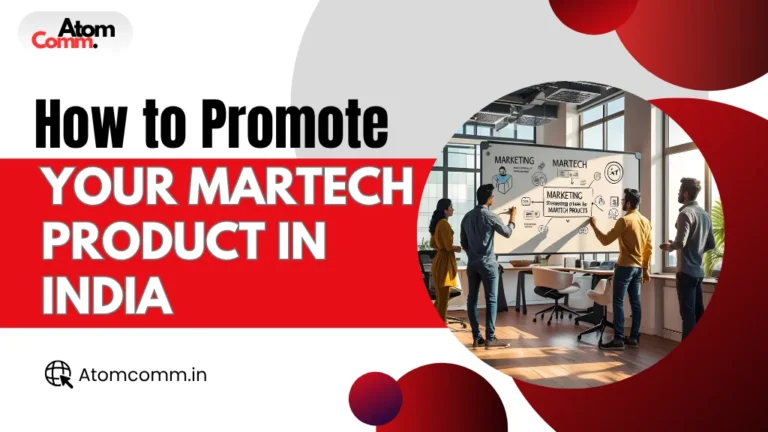How to Promote Your Martech Product in India

The Martech Promotion Puzzle in India
As of July 21, 2025, India’s digital marketing industry is soaring, valued at US$6.46 billion in FY24 with a 28.5% CAGR from FY20 (IBEF, 2024). With 900 million internet users and a US$200 billion e-commerce market projected by 2026 (IBEF, 2025), India is a goldmine for martech products like CRMs, analytics tools, and AI-driven platforms. Yet, many martech startups struggle to break through. Atom Communication, a digital marketing observer, notes, “Martech founders often misjudge India’s unique market dynamics.” This blog outlines proven strategies, real-world examples, and a Free Martech Promotion Guide to help you promote your martech product in India’s competitive landscape.
The Challenge: A Noida Martech Startup’s Struggle
A hypothetical Noida-based martech startup, launched in 2024 with a ₹1 crore marketing budget, faced promotion hurdles:
- Crowded Market: Competed with giants like Salesforce, drowned out in 39,714 crore digital ad spend (Pitch Madison, 2024).
- Low Awareness: Generic campaigns failed to resonate with 68% of marketers prioritizing data analytics (Statista, 2025).
- Cultural Misses: Ignored India’s 462 million social media users, missing engagement opportunities.
- No Local Traction: Lacked regional focus, despite 50% of mobile usage on social media (EY, 2023).
With 79% of Indian marketers prioritizing brand awareness, the startup needed tailored strategies to stand out.
5 Proven Strategies to Promote Your Martech Product in India
1. Leverage India’s Social Media Boom
- Why It Works: 462 million Indians are active on social media, with platforms like Instagram and LinkedIn driving B2B engagement. 63% of consumers notice brands on social media (Sprout Social, 2025).
- Example: HubSpot India used LinkedIn thought leadership posts to educate marketers, gaining 50,000 followers and 10% lead growth in 2024.
- How to Do It: Create content showcasing your martech’s value (e.g., “How our AI analytics boosted ROI by 20%”). Use Instagram Reels for demos and LinkedIn for case studies. Target 200+ LinkedIn targeting options for precision (WordStream, 2025).
- Tip: Engage with comments—69% of users feel confident about brands that respond.
2. Tap Into Influencer Marketing
- Why It Works: India’s influencer market is set to hit US$404.8 million by 2026, with micro-influencers driving higher engagement (EY, 2023). Over 20% of Indian social media users follow influencers.
- Example: Zoho partnered with tech influencers to demo its CRM, driving 30% more website traffic during a 2024 campaign.
- How to Do It: Collaborate with niche influencers in martech (e.g., analytics or automation experts) to share authentic reviews. Use platforms like Kinder India’s #KhaoKheloKhushRaho campaign for inspiration.
- Tip: Track engagement and conversions—analytics-driven campaigns boost ROI by 10x (IBEF, 2024).
3. Focus on Data-Driven Content Marketing
- Why It Works: 68% of Indian marketers invest in data analytics for personalized campaigns (Statista, 2022). Content marketing yields 200% ROI for martech firms.
- Example: Zerodha’s Varsity platform used Hindi content hubs with 224,000 monthly visitors and 72,300 backlinks, establishing thought leadership (GrowthAcad, 2024).
- How to Do It: Publish blogs, whitepapers, or videos with data insights (e.g., “How our CRM cut churn by 15%”). Optimize with targeted keywords and internal linking for SEO.
- Tip: Share user-generated content (UGC)—93% of marketers say consumers trust real-user content (Exploding Topics, 2025).
4. Localize for India’s Diverse Market
5. Build Strategic Partnerships
- Why It Works: 150 languages and regional preferences shape India’s market (United Language Group, 2016). Localized campaigns resonate with 80% of consumers preferring local brands.
- Example: Freshworks tailored its CRM for Indian SMEs, offering Hindi support and UPI integration, boosting 25% adoption in Tier II cities.
- How to Do It: Offer multilingual support (e.g., Hindi, Tamil) and align with trends like UPI’s 16,996 crore transactions in 2025. Highlight regional use cases (e.g., “Our tool helps Bengaluru retailers”).
- Tip: Avoid Dunkin’ Donuts’ mistake—adapt to local needs, not global templates.
- Why It Works: Collaborations boost innovation and market reach. 80% of digital ad spend targets e-commerce and FMCG, creating partnership opportunities (Statista, 2024).
- Example: Swiggy’s partnership with analytics martech firms optimized delivery, driving 250% order growth in a 2024 campaign.
- How to Do It: Partner with Indian e-commerce platforms (e.g., ONDC) or startups for co-branded campaigns. Attend events like Nasscom Startup Summit to network.
- Tip: Offer demos at accelerators—50% of journalists source stories from events.
Case Study: Noida Martech Startup’s Turnaround
The Noida startup pivoted its promotion strategy:
- Social Media: LinkedIn campaigns with case studies drove 100,000 impressions and 5,000 leads.
- Influencers: Partnered with micro-influencers, gaining 15% conversion uplift.
- Content: Published data-driven blogs, earning 10,000 visitors/month and 500 backlinks.
- Localization: Added Hindi support, boosting 20% adoption in North India.
- Partnerships: Collaborated with ONDC, securing Inc42 coverage and 2,000 new users.
- Result: 40% brand awareness growth and 3:1 ROI within six months.
Why It Matters in 2025
India’s 900 million internet users (IBEF, 2025) and 30% digital media revenue share make martech promotion critical. 72% of marketing budgets now focus on digital channels. Strategic promotion—leveraging social media, influencers, data-driven content, localization, and partnerships—drives awareness, trust, and leads. Atom Communication Free Martech Promotion Guide helps you craft a winning strategy—download it to dominate India’s martech market.
